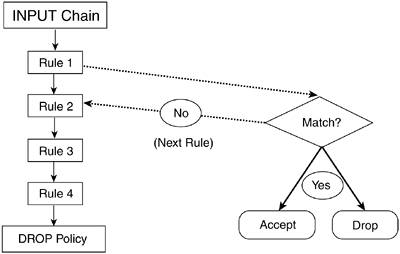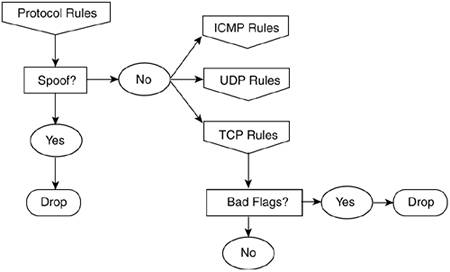User-Defined Chains
| The filter table has three permanent, built-in chains: INPUT, OUTPUT, and FORWARD. iptables enables you to define chains of your own, called user-defined chains. These user-defined chains are treated as rule targetsthat is, based on the set of matches specified in a rule, the target can branch off or jump to a user-defined chain. Rather than the packet being accepted or dropped, control is passed to the user-defined chain to perform more specific match tests relative to packets matching the branch rule. After the user-defined chain is traversed, control returns to the calling chain, and matching continues from the next rule in the calling chain unless the user-defined chain matched and took action on the packet. Figure 5.3 shows the standard, top-down rule traversal using the built-in chains. Figure 5.3. Standard chain traversal.
User-defined chains are useful in optimizing the ruleset and therefore are often used. They allow the rules to be organized into categorical trees. Rather than relying on the straight-through, top-down check-off list type of matching inherent in the standard chain traversal, packet match tests can be selectively narrowed down based on the characteristics of the packet. Figure 5.4 shows initial packet flow. After initial tests common to all incoming packets are performed, packet matching branches off based on the destination address in the packet. Figure 5.4. User-defined chains based on destination address.
Branching is based on destination address in this example. Source address matching is done later in relation to specific applications, such as remote DNS or mail servers. In most cases, the remote address will be "anywhere." Matching on destination address at this point distinguishes between unicast packets targeted to this machine, broadcast packets, multicast packets, and (depending on whether it's the INPUT or FORWARD chain) packets targeted to internal hosts. Figure 5.5 details the user-defined chain for the protocol rules for packets specifically addressed to this host. As shown, user-defined chains can jump to other user-defined chains containing even more specific tests. Figure 5.5. User-defined chains based on protocol.
This list summarizes the characteristics of user-defined chains from Chapter 3, "iptables: The Linux Firewall Administration Program":
The next section takes advantage of user-defined chains and the concepts presented in the section on rule organization to optimize the single-system firewall presented in Chapter 4. |
EAN: 2147483647
Pages: 163
- Chapter IV How Consumers Think About Interactive Aspects of Web Advertising
- Chapter VI Web Site Quality and Usability in E-Commerce
- Chapter IX Extrinsic Plus Intrinsic Human Factors Influencing the Web Usage
- Chapter XIV Product Catalog and Shopping Cart Effective Design
- Chapter XVIII Web Systems Design, Litigation, and Online Consumer Behavior


